VOLVO XC60 TWIN ENGINE 2019 Owners Manual
Manufacturer: VOLVO, Model Year: 2019, Model line: XC60 TWIN ENGINE, Model: VOLVO XC60 TWIN ENGINE 2019Pages: 695, PDF Size: 14.96 MB
Page 311 of 695
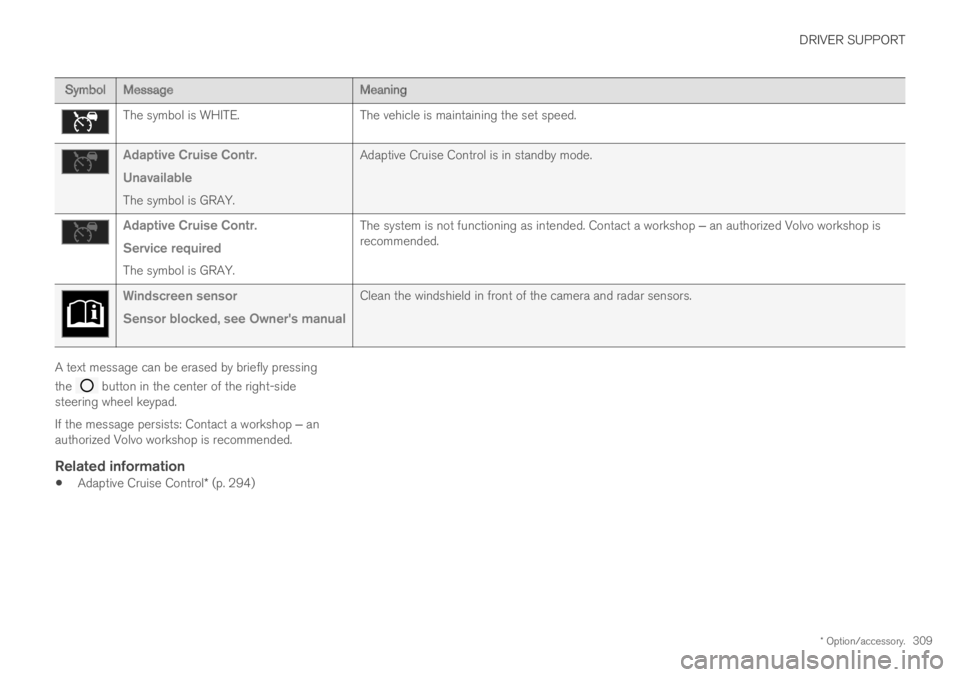
DRIVER SUPPORT
* Option/accessory.309
SymbolMessageMeaning
The symbol is WHITE.The vehicle is maintaining the set speed.
Adaptive Cruise Contr.
Unavailable
The symbol is GRAY.
Adaptive Cruise Control is in standby mode.
Adaptive Cruise Contr.
Service required
The symbol is GRAY.
The system is not functioning as intended. Contact a workshop ‒ an authorized Volvo workshop isrecommended.
Windscreen sensor
Sensor blocked, see Owner's manual
Clean the windshield in front of the camera and radar sensors.
A text message can be erased by briefly pressing
the button in the center of the right-sidesteering wheel keypad.
If the message persists: Contact a workshop ‒ anauthorized Volvo workshop is recommended.
Related information
Adaptive Cruise Control* (p. 294)
Page 312 of 695
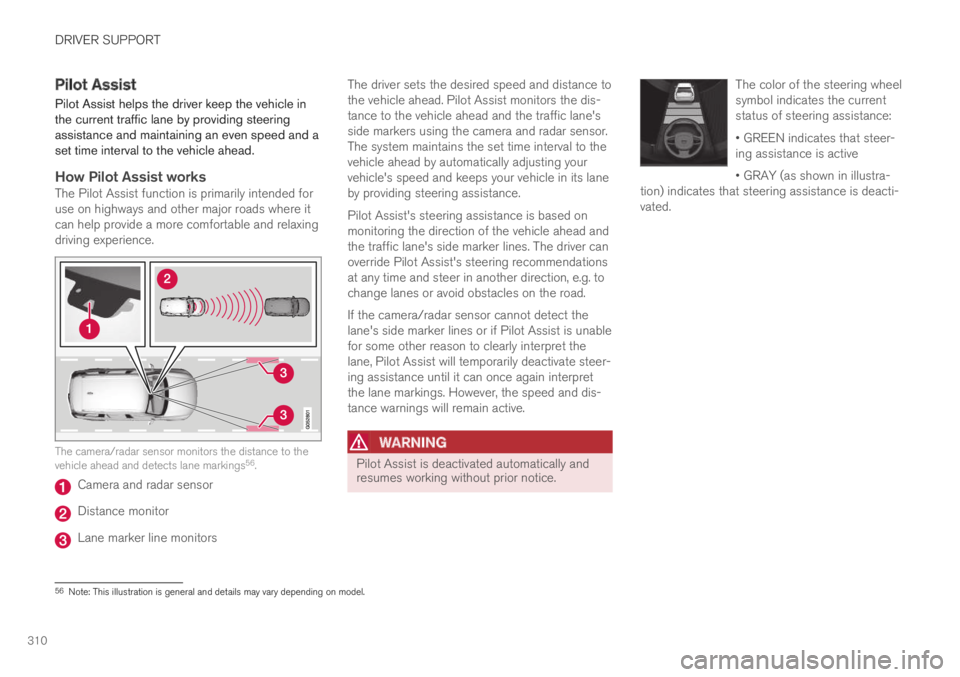
DRIVER SUPPORT
310
Pilot Assist
Pilot Assist helps the driver keep the vehicle inthe current traffic lane by providing steeringassistance and maintaining an even speed and aset time interval to the vehicle ahead.
How Pilot Assist works
The Pilot Assist function is primarily intended foruse on highways and other major roads where itcan help provide a more comfortable and relaxingdriving experience.
The camera/radar sensor monitors the distance to thevehicle ahead and detects lane markings56.
Camera and radar sensor
Distance monitor
Lane marker line monitors
The driver sets the desired speed and distance tothe vehicle ahead. Pilot Assist monitors the dis-tance to the vehicle ahead and the traffic lane'sside markers using the camera and radar sensor.The system maintains the set time interval to thevehicle ahead by automatically adjusting yourvehicle's speed and keeps your vehicle in its laneby providing steering assistance.
Pilot Assist's steering assistance is based onmonitoring the direction of the vehicle ahead andthe traffic lane's side marker lines. The driver canoverride Pilot Assist's steering recommendationsat any time and steer in another direction, e.g. tochange lanes or avoid obstacles on the road.
If the camera/radar sensor cannot detect thelane's side marker lines or if Pilot Assist is unablefor some other reason to clearly interpret thelane, Pilot Assist will temporarily deactivate steer-ing assistance until it can once again interpretthe lane markings. However, the speed and dis-tance warnings will remain active.
WARNING
Pilot Assist is deactivated automatically andresumes working without prior notice.
The color of the steering wheelsymbol indicates the currentstatus of steering assistance:
• GREEN indicates that steer-ing assistance is active
• GRAY (as shown in illustra-tion) indicates that steering assistance is deacti-vated.
56Note: This illustration is general and details may vary depending on model.
Page 313 of 695
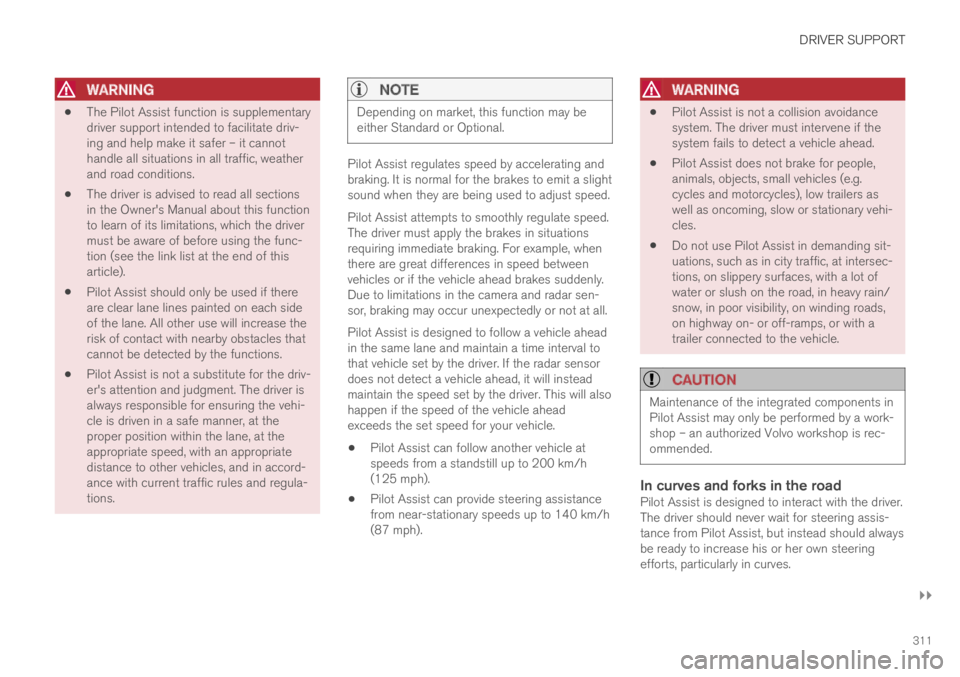
DRIVER SUPPORT
}}
311
WARNING
The Pilot Assist function is supplementarydriver support intended to facilitate driv-ing and help make it safer – it cannothandle all situations in all traffic, weatherand road conditions.
The driver is advised to read all sectionsin the Owner's Manual about this functionto learn of its limitations, which the drivermust be aware of before using the func-tion (see the link list at the end of thisarticle).
Pilot Assist should only be used if thereare clear lane lines painted on each sideof the lane. All other use will increase therisk of contact with nearby obstacles thatcannot be detected by the functions.
Pilot Assist is not a substitute for the driv-er's attention and judgment. The driver isalways responsible for ensuring the vehi-cle is driven in a safe manner, at theproper position within the lane, at theappropriate speed, with an appropriatedistance to other vehicles, and in accord-ance with current traffic rules and regula-tions.
NOTE
Depending on market, this function may beeither Standard or Optional.
Pilot Assist regulates speed by accelerating andbraking. It is normal for the brakes to emit a slightsound when they are being used to adjust speed.
Pilot Assist attempts to smoothly regulate speed.The driver must apply the brakes in situationsrequiring immediate braking. For example, whenthere are great differences in speed betweenvehicles or if the vehicle ahead brakes suddenly.Due to limitations in the camera and radar sen-sor, braking may occur unexpectedly or not at all.
Pilot Assist is designed to follow a vehicle aheadin the same lane and maintain a time interval tothat vehicle set by the driver. If the radar sensordoes not detect a vehicle ahead, it will insteadmaintain the speed set by the driver. This will alsohappen if the speed of the vehicle aheadexceeds the set speed for your vehicle.
Pilot Assist can follow another vehicle atspeeds from a standstill up to 200 km/h(125 mph).
Pilot Assist can provide steering assistancefrom near-stationary speeds up to 140 km/h(87 mph).
WARNING
Pilot Assist is not a collision avoidancesystem. The driver must intervene if thesystem fails to detect a vehicle ahead.
Pilot Assist does not brake for people,animals, objects, small vehicles (e.g.cycles and motorcycles), low trailers aswell as oncoming, slow or stationary vehi-cles.
Do not use Pilot Assist in demanding sit-uations, such as in city traffic, at intersec-tions, on slippery surfaces, with a lot ofwater or slush on the road, in heavy rain/snow, in poor visibility, on winding roads,on highway on- or off-ramps, or with atrailer connected to the vehicle.
CAUTION
Maintenance of the integrated components inPilot Assist may only be performed by a work-shop – an authorized Volvo workshop is rec-ommended.
In curves and forks in the road
Pilot Assist is designed to interact with the driver.The driver should never wait for steering assis-tance from Pilot Assist, but instead should alwaysbe ready to increase his or her own steeringefforts, particularly in curves.
Page 314 of 695
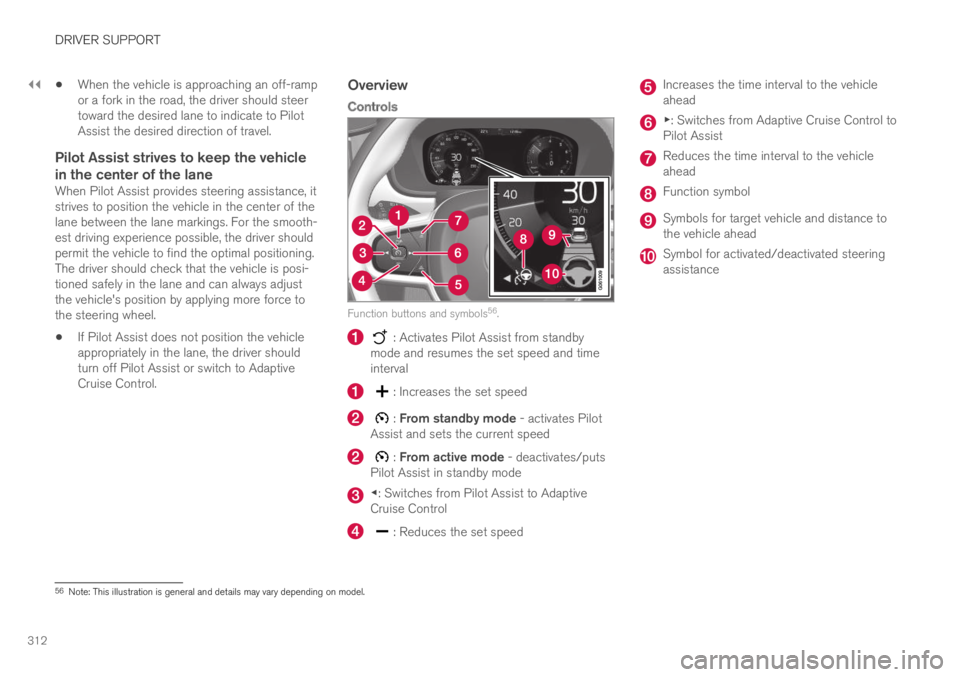
||
DRIVER SUPPORT
312
When the vehicle is approaching an off-rampor a fork in the road, the driver should steertoward the desired lane to indicate to PilotAssist the desired direction of travel.
Pilot Assist strives to keep the vehicle
in the center of the lane
When Pilot Assist provides steering assistance, itstrives to position the vehicle in the center of thelane between the lane markings. For the smooth-est driving experience possible, the driver shouldpermit the vehicle to find the optimal positioning.The driver should check that the vehicle is posi-tioned safely in the lane and can always adjustthe vehicle's position by applying more force tothe steering wheel.
If Pilot Assist does not position the vehicleappropriately in the lane, the driver shouldturn off Pilot Assist or switch to AdaptiveCruise Control.
Overview
Controls
Function buttons and symbols56.
: Activates Pilot Assist from standbymode and resumes the set speed and timeinterval
: Increases the set speed
: From standby mode - activates PilotAssist and sets the current speed
: From active mode - deactivates/putsPilot Assist in standby mode
◀: Switches from Pilot Assist to AdaptiveCruise Control
: Reduces the set speed
Increases the time interval to the vehicleahead
▶: Switches from Adaptive Cruise Control toPilot Assist
Reduces the time interval to the vehicleahead
Function symbol
Symbols for target vehicle and distance tothe vehicle ahead
Symbol for activated/deactivated steeringassistance
56Note: This illustration is general and details may vary depending on model.
Page 315 of 695
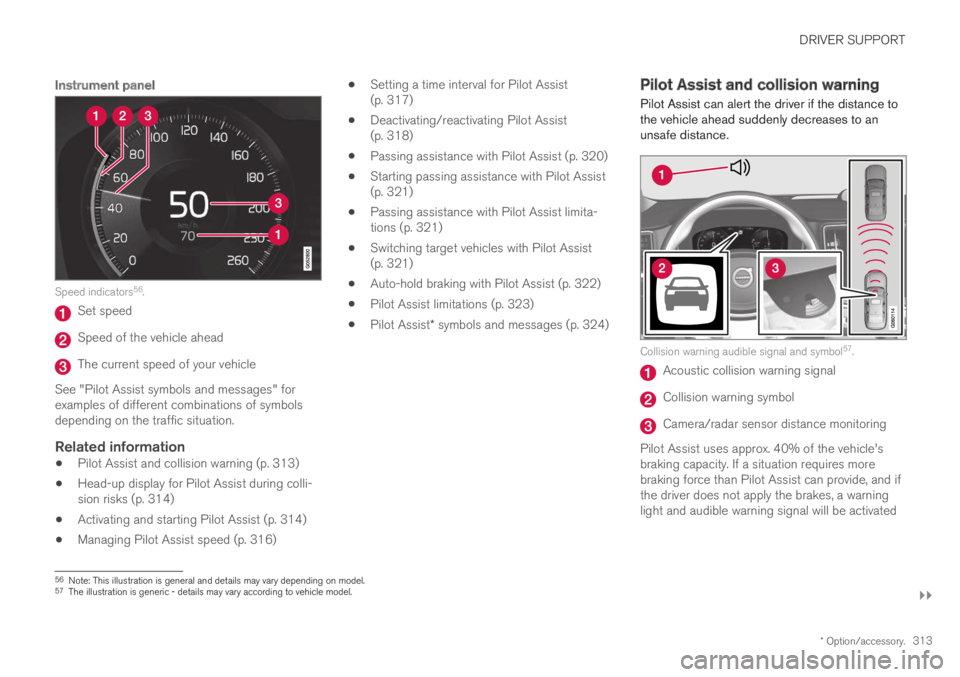
DRIVER SUPPORT
}}
* Option/accessory.313
Instrument panel
Speed indicators56.
Set speed
Speed of the vehicle ahead
The current speed of your vehicle
See "Pilot Assist symbols and messages" forexamples of different combinations of symbolsdepending on the traffic situation.
Related information
Pilot Assist and collision warning (p. 313)
Head-up display for Pilot Assist during colli-sion risks (p. 314)
Activating and starting Pilot Assist (p. 314)
Managing Pilot Assist speed (p. 316)
Setting a time interval for Pilot Assist(p. 317)
Deactivating/reactivating Pilot Assist(p. 318)
Passing assistance with Pilot Assist (p. 320)
Starting passing assistance with Pilot Assist(p. 321)
Passing assistance with Pilot Assist limita-tions (p. 321)
Switching target vehicles with Pilot Assist(p. 321)
Auto-hold braking with Pilot Assist (p. 322)
Pilot Assist limitations (p. 323)
Pilot Assist* symbols and messages (p. 324)
Pilot Assist and collision warning
Pilot Assist can alert the driver if the distance tothe vehicle ahead suddenly decreases to anunsafe distance.
Collision warning audible signal and symbol57.
Acoustic collision warning signal
Collision warning symbol
Camera/radar sensor distance monitoring
Pilot Assist uses approx. 40% of the vehicle'sbraking capacity. If a situation requires morebraking force than Pilot Assist can provide, and ifthe driver does not apply the brakes, a warninglight and audible warning signal will be activated
56Note: This illustration is general and details may vary depending on model.57The illustration is generic - details may vary according to vehicle model.
Page 316 of 695
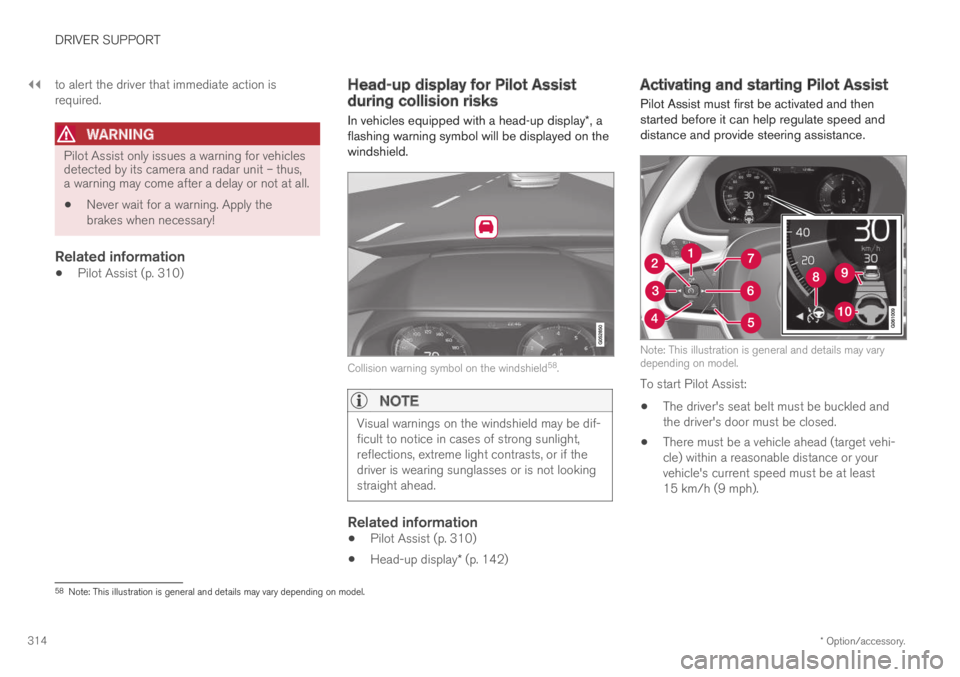
||
DRIVER SUPPORT
* Option/accessory.314
to alert the driver that immediate action isrequired.
WARNING
Pilot Assist only issues a warning for vehiclesdetected by its camera and radar unit – thus,a warning may come after a delay or not at all.
Never wait for a warning. Apply thebrakes when necessary!
Related information
Pilot Assist (p. 310)
Head-up display for Pilot Assistduring collision risks
In vehicles equipped with a head-up display*, aflashing warning symbol will be displayed on thewindshield.
Collision warning symbol on the windshield58.
NOTE
Visual warnings on the windshield may be dif-ficult to notice in cases of strong sunlight,reflections, extreme light contrasts, or if thedriver is wearing sunglasses or is not lookingstraight ahead.
Related information
Pilot Assist (p. 310)
Head-up display* (p. 142)
Activating and starting Pilot Assist
Pilot Assist must first be activated and thenstarted before it can help regulate speed anddistance and provide steering assistance.
Note: This illustration is general and details may varydepending on model.
To start Pilot Assist:
The driver's seat belt must be buckled andthe driver's door must be closed.
There must be a vehicle ahead (target vehi-cle) within a reasonable distance or yourvehicle's current speed must be at least15 km/h (9 mph).
58Note: This illustration is general and details may vary depending on model.
Page 317 of 695
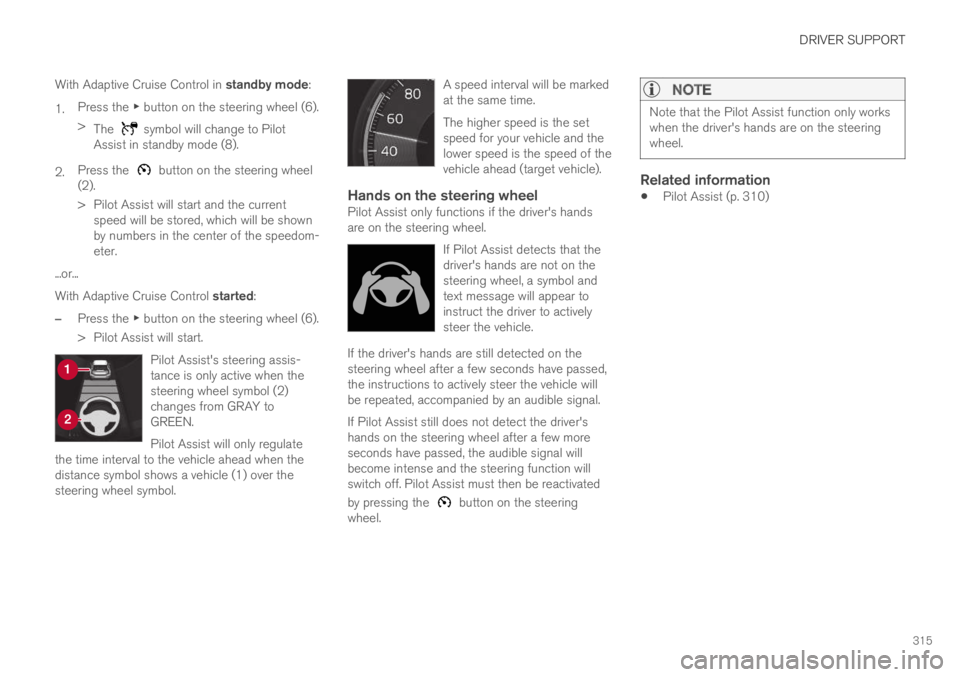
DRIVER SUPPORT
315
With Adaptive Cruise Control in standby mode:
1.Press the ▶ button on the steering wheel (6).
>The symbol will change to PilotAssist in standby mode (8).
2.Press the button on the steering wheel(2).
>Pilot Assist will start and the currentspeed will be stored, which will be shownby numbers in the center of the speedom-eter.
...or...
With Adaptive Cruise Control started:
–Press the ▶ button on the steering wheel (6).
>Pilot Assist will start.
Pilot Assist's steering assis-tance is only active when thesteering wheel symbol (2)changes from GRAY toGREEN.
Pilot Assist will only regulatethe time interval to the vehicle ahead when thedistance symbol shows a vehicle (1) over thesteering wheel symbol.
A speed interval will be markedat the same time.
The higher speed is the setspeed for your vehicle and thelower speed is the speed of thevehicle ahead (target vehicle).
Hands on the steering wheel
Pilot Assist only functions if the driver's handsare on the steering wheel.
If Pilot Assist detects that thedriver's hands are not on thesteering wheel, a symbol andtext message will appear toinstruct the driver to activelysteer the vehicle.
If the driver's hands are still detected on thesteering wheel after a few seconds have passed,the instructions to actively steer the vehicle willbe repeated, accompanied by an audible signal.
If Pilot Assist still does not detect the driver'shands on the steering wheel after a few moreseconds have passed, the audible signal willbecome intense and the steering function willswitch off. Pilot Assist must then be reactivated
by pressing the button on the steeringwheel.
NOTE
Note that the Pilot Assist function only workswhen the driver's hands are on the steeringwheel.
Related information
Pilot Assist (p. 310)
Page 318 of 695
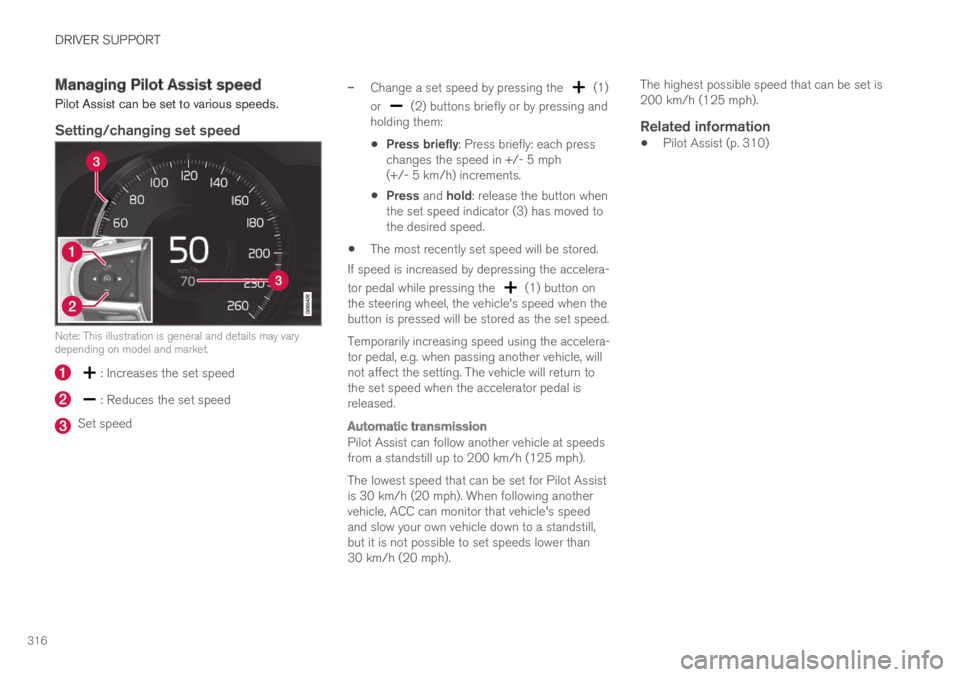
DRIVER SUPPORT
316
Managing Pilot Assist speed
Pilot Assist can be set to various speeds.
Setting/changing set speed
Note: This illustration is general and details may varydepending on model and market.
: Increases the set speed
: Reduces the set speed
Set speed
–Change a set speed by pressing the (1)
or (2) buttons briefly or by pressing andholding them:
Press briefly: Press briefly: each presschanges the speed in +/- 5 mph(+/- 5 km/h) increments.
Press and hold: release the button whenthe set speed indicator (3) has moved tothe desired speed.
The most recently set speed will be stored.
If speed is increased by depressing the accelera-
tor pedal while pressing the (1) button onthe steering wheel, the vehicle's speed when thebutton is pressed will be stored as the set speed.
Temporarily increasing speed using the accelera-tor pedal, e.g. when passing another vehicle, willnot affect the setting. The vehicle will return tothe set speed when the accelerator pedal isreleased.
Automatic transmission
Pilot Assist can follow another vehicle at speedsfrom a standstill up to 200 km/h (125 mph).
The lowest speed that can be set for Pilot Assistis 30 km/h (20 mph). When following anothervehicle, ACC can monitor that vehicle's speedand slow your own vehicle down to a standstill,but it is not possible to set speeds lower than30 km/h (20 mph).
The highest possible speed that can be set is200 km/h (125 mph).
Related information
Pilot Assist (p. 310)
Page 319 of 695
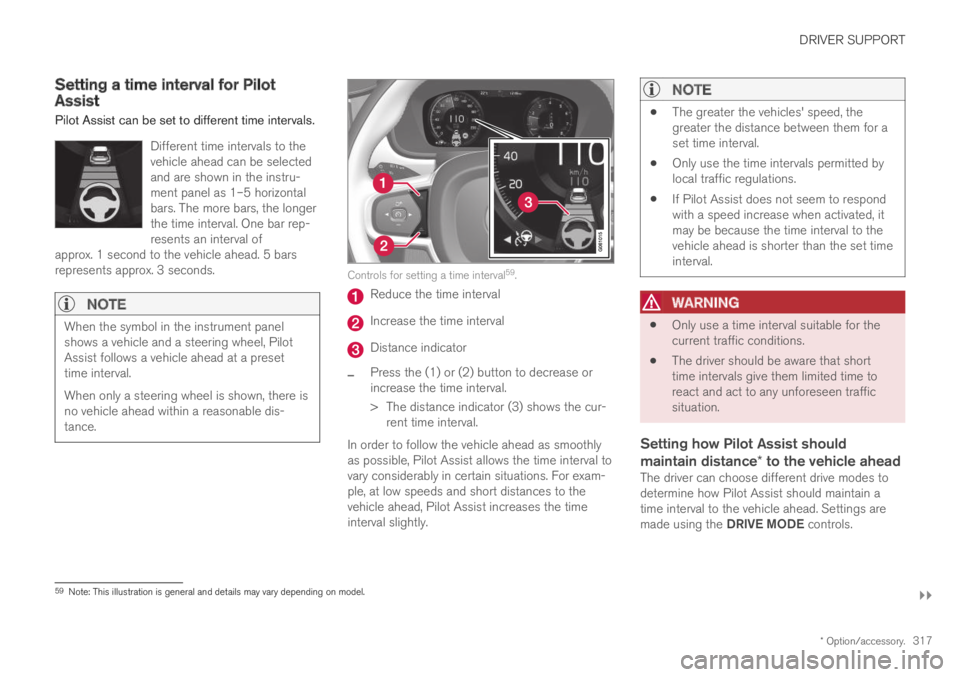
DRIVER SUPPORT
}}
* Option/accessory.317
Setting a time interval for PilotAssist
Pilot Assist can be set to different time intervals.
Different time intervals to thevehicle ahead can be selectedand are shown in the instru-ment panel as 1–5 horizontalbars. The more bars, the longerthe time interval. One bar rep-resents an interval ofapprox. 1 second to the vehicle ahead. 5 barsrepresents approx. 3 seconds.
NOTE
When the symbol in the instrument panelshows a vehicle and a steering wheel, PilotAssist follows a vehicle ahead at a presettime interval.
When only a steering wheel is shown, there isno vehicle ahead within a reasonable dis-tance.
Controls for setting a time interval59.
Reduce the time interval
Increase the time interval
Distance indicator
–Press the (1) or (2) button to decrease orincrease the time interval.
>The distance indicator (3) shows the cur-rent time interval.
In order to follow the vehicle ahead as smoothlyas possible, Pilot Assist allows the time interval tovary considerably in certain situations. For exam-ple, at low speeds and short distances to thevehicle ahead, Pilot Assist increases the timeinterval slightly.
NOTE
The greater the vehicles' speed, thegreater the distance between them for aset time interval.
Only use the time intervals permitted bylocal traffic regulations.
If Pilot Assist does not seem to respondwith a speed increase when activated, itmay be because the time interval to thevehicle ahead is shorter than the set timeinterval.
WARNING
Only use a time interval suitable for thecurrent traffic conditions.
The driver should be aware that shorttime intervals give them limited time toreact and act to any unforeseen trafficsituation.
Setting how Pilot Assist should
maintain distance * to the vehicle ahead
The driver can choose different drive modes todetermine how Pilot Assist should maintain atime interval to the vehicle ahead. Settings aremade using the DRIVE MODE controls.
59Note: This illustration is general and details may vary depending on model.
Page 320 of 695
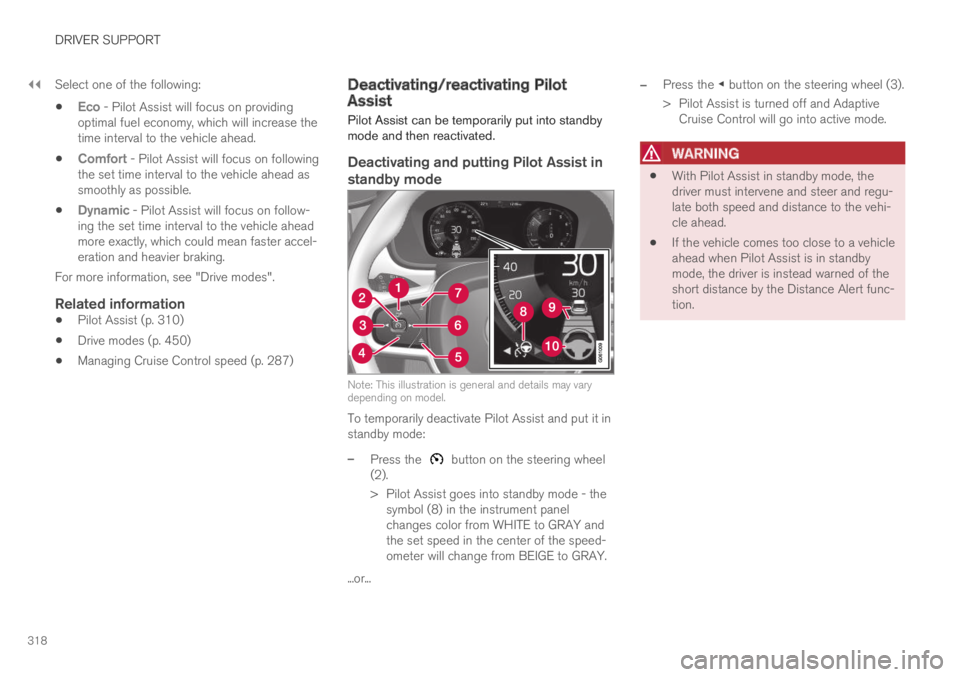
||
DRIVER SUPPORT
318
Select one of the following:
Eco - Pilot Assist will focus on providingoptimal fuel economy, which will increase thetime interval to the vehicle ahead.
Comfort - Pilot Assist will focus on followingthe set time interval to the vehicle ahead assmoothly as possible.
Dynamic - Pilot Assist will focus on follow-ing the set time interval to the vehicle aheadmore exactly, which could mean faster accel-eration and heavier braking.
For more information, see "Drive modes".
Related information
Pilot Assist (p. 310)
Drive modes (p. 450)
Managing Cruise Control speed (p. 287)
Deactivating/reactivating PilotAssist
Pilot Assist can be temporarily put into standbymode and then reactivated.
Deactivating and putting Pilot Assist in
standby mode
Note: This illustration is general and details may varydepending on model.
To temporarily deactivate Pilot Assist and put it instandby mode:
–Press the button on the steering wheel(2).
>Pilot Assist goes into standby mode - thesymbol (8) in the instrument panelchanges color from WHITE to GRAY andthe set speed in the center of the speed-ometer will change from BEIGE to GRAY.
...or...
–Press the ◀ button on the steering wheel (3).
>Pilot Assist is turned off and AdaptiveCruise Control will go into active mode.
WARNING
With Pilot Assist in standby mode, thedriver must intervene and steer and regu-late both speed and distance to the vehi-cle ahead.
If the vehicle comes too close to a vehicleahead when Pilot Assist is in standbymode, the driver is instead warned of theshort distance by the Distance Alert func-tion.